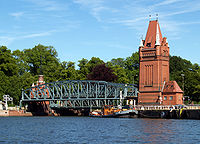
Elbe-Lübeck Canal
Encyclopedia

Canal
Canals are man-made channels for water. There are two types of canal:#Waterways: navigable transportation canals used for carrying ships and boats shipping goods and conveying people, further subdivided into two kinds:...
in Schleswig-Holstein
Schleswig-Holstein
Schleswig-Holstein is the northernmost of the sixteen states of Germany, comprising most of the historical duchy of Holstein and the southern part of the former Duchy of Schleswig...
, Germany
Germany
Germany , officially the Federal Republic of Germany , is a federal parliamentary republic in Europe. The country consists of 16 states while the capital and largest city is Berlin. Germany covers an area of 357,021 km2 and has a largely temperate seasonal climate...
. It connects the Elbe
Elbe
The Elbe is one of the major rivers of Central Europe. It rises in the Krkonoše Mountains of the northwestern Czech Republic before traversing much of Bohemia , then Germany and flowing into the North Sea at Cuxhaven, 110 km northwest of Hamburg...
and Trave
Trave
The Trave is a river in Schleswig-Holstein, Germany. It is approximately 124 kilometres long, running from its source near the village of Gießelrade in Ostholstein to Travemünde where it flows into the Baltic Sea. It passes through Bad Segeberg, Bad Oldesloe, and Lübeck, where it is linked to the...
rivers, hence constituting an accessway from the Elbe to the Baltic Sea
Baltic Sea
The Baltic Sea is a brackish mediterranean sea located in Northern Europe, from 53°N to 66°N latitude and from 20°E to 26°E longitude. It is bounded by the Scandinavian Peninsula, the mainland of Europe, and the Danish islands. It drains into the Kattegat by way of the Øresund, the Great Belt and...
. It is 67 kilometres (42 mi) long; the northern terminus is Lübeck
Lübeck
The Hanseatic City of Lübeck is the second-largest city in Schleswig-Holstein, in northern Germany, and one of the major ports of Germany. It was for several centuries the "capital" of the Hanseatic League and, because of its Brick Gothic architectural heritage, is listed by UNESCO as a World...
, the southern terminus is the town of Lauenburg. The town of Mölln is along the canal.
The predecessor was the Stecknitz Canal, built under Eric IV, Duke of Saxe-Lauenburg
Eric IV, Duke of Saxe-Lauenburg
Eric IV of Saxe-Lauenburg was a son of Duke Eric II of Saxe-Lauenburg and Agnes of Schauenburg and Holstein-Plön, daughter of Count John III of Schauenburg and Holstein-Plön.-Life:...
, between 1390 and 1398, making it one of the oldest artificial waterways of Europe. This canal connected the tiny rivers Stecknitz (tributary of the Trave) and Delvenau (tributary of the Elbe). It was a part of the Old Salt Route
Old Salt Route
The Old Salt Route was a medieval trade route in northern Germany, one of the ancient network of salt roads which were used primarily for the transport of salt and other staples...
. The Stecknitz Canal was 85 centimetres (33 in) deep, 7.5 metre wide and 94 kilometres (58 mi) long. The canal included 17 wooden locks of which the Palmschleuse at Lauenburg still exists.
According to authors David Kirby
David Kirby (academic)
David G. Kirby is a Professor at the School of Slavonic and East European Studies, University of London.-Selected Bibliography:* Finland in the Twentieth Century * Northern Europe in the Early Modern Period * The Baltic World 1772–1993...
and Merja-Liisa Hinkkanen, "the journey (along the Stecknitz) often lasted up to fourteen days, due to the number of locks and the inadequacy of the towpath. A number of plans for a new Baltic–North Sea canal were floated in the 17th century, but none came to fruition." See "The Baltic and North Seas", Routledge, London and New York, 2000, p. 72.
In 1900 the old canal was replaced by the present Elbe-Lübeck Canal. It was partly laid out using the Stecknitz, the Delvenau and the old canal. The new canal was generally straightened, thus reducing the length to the current 67 km figure.

